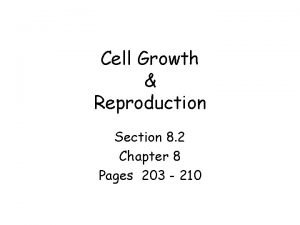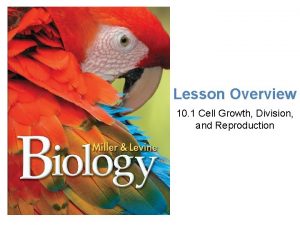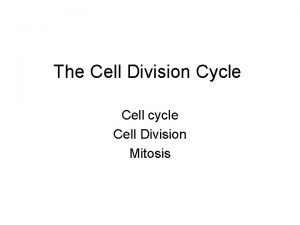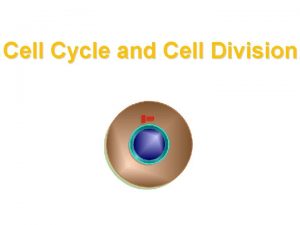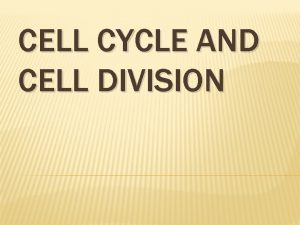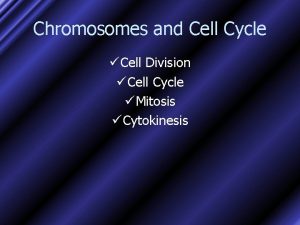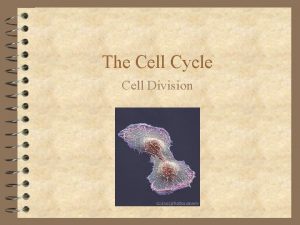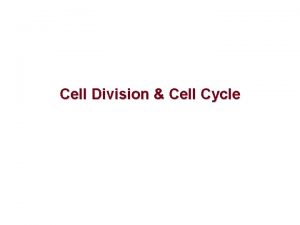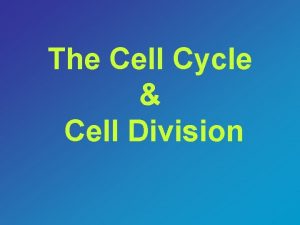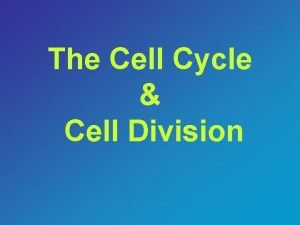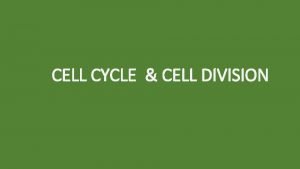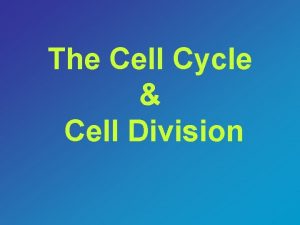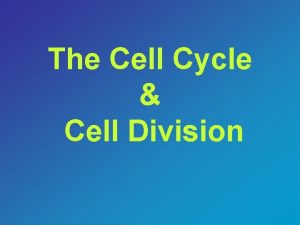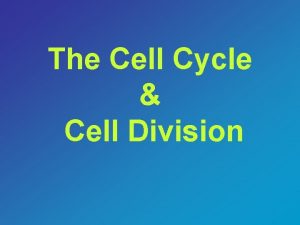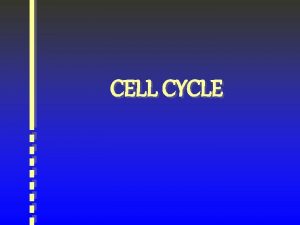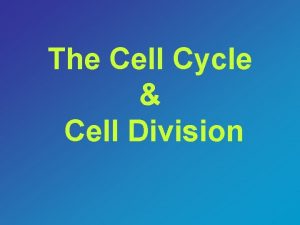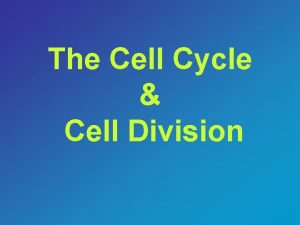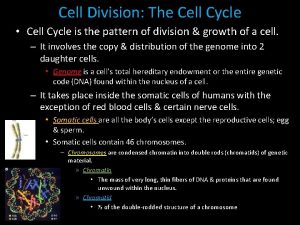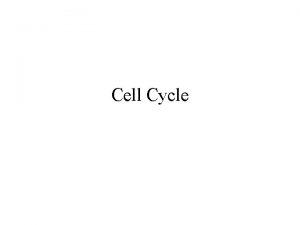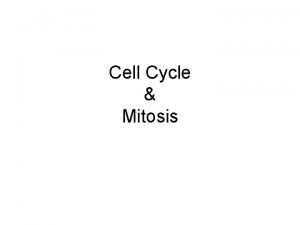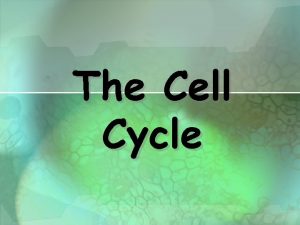THE CELL CYCLE AND CELL DIVISION LS Chapter

























- Slides: 25

THE CELL CYCLE AND CELL DIVISION LS Chapter 3

The Cell Cycle • Every organism begins as a single cell • In animals, including humans: sperm fertilizes egg • • How, then, does the zygote become millions or trillions of cells? • Cells divide • • Fertilized egg is called a zygote 1 cell becomes 2, which become 4, which become 8 and so on Cells have a life of their own • They grow, develop, then divide • This is called the cell cycle

Some Terms That May Prove Confusing • Centriole-The cell structure that assists in cell division • • Chromatin- Thin, unwound strands of DNA • • Made up of microtubules Present in Interphase Chromatids-DNA that is wound into a tight structure • There are 2, and they are called ________________ • Chromosomes-Sister chromatids that are attached to one another • Centromere-The place at which the sister chromatids attach to form the chromosome



Phases of the Cell Cycle • IPMAT • Interphase • Mitosis Prophase • Metaphase • Anaphase • Telophase • • Cytokinesis

Interphase (Intermission) • The resting phase of the cell • Cells spend a majority of their lives in interphase • The growth and development stage • 3 parts of interphase • G 1 Phase (Gap phase 1) • • Cell grows and functions as normal S phase • DNA duplicates • • • The cell then has 2 x as much DNA as it normally does DNA is in the form of chromatin (thin strands) G 2 Phase (Gap phase 2) • Cell grows again, and finishes duplicating organelles

Mitosis • The period of nuclear division • • Results in 2 identical nuclei 4 parts (PMAT) Prophase • Metaphase • Anaphase • Telophase •

Prophase (Prologue) • Chromatin coils into X-shaped chromosomes • Chromosomes are made of 2 identical sides called sister chromatids • Nucleolus disappears • Nuclear membrane disappears • Centrioles begin to move to pole of the cell • Spindle begins to form • Spindle is made of microtubules

Metaphase (Middle) • Spindles attach to centromere of the chromosome and pull chromosomes into the middle (equator) of the cell • Very important because it ensures that, when the chromosomes split, exactly ½ of each chromosomes (1 sister chromatid) will move to each end of the cell • When the cell splits, it will then have exactly the same DNA as the parent cell (the one that split into the 2 new ones)

Anaphase (Apart) • Spindle fibers shorten • Sister chromatids are pulled apart at the centromere • One sister chromatid moves to each pole (end) of the cell

Telophase (Two) • Spindle breaks down • Chromatids uncoil into chromatin • A nucleus forms around each of the 2 sets of chromatin • One forms on each side of the cell • • This results in 2 identical nuclei The cell begins to split

Cytokinesis • Occurs immediately after mitosis • Cyto=Cell • Kinesis=movement • The cytoplasm splits • Results in 2 identical cells • • Called the daughter cells Happens differently in plant and animal cells In animals, the cytoplasm pinches in until it splits • In plants, this cannot happen due to the cell wall • • • Instead, a structure called a cell plate forms, splitting the cells After cytokinesis, cells are back in G 1 and the cycle is ready to repeat.




Results of Cell Division • Cytokinesis results in 2 new, identical cells • Some unicellular organisms use a similar method as their reproduction • • Called binary fission, the parent cell splits into 2 daughter cells, each being an organism Multicellular organisms use cell division to make new cells for several reasons • Growth • As you grow, you must add new cells • • Repair • Damage to the body kills cells • • • Zygote splits into 2, which split into 4, which split into 8…etc. They need to be replaced This could be a scrape, a cut, a broken bone, etc. Replacement • You lose thousands of cells a day, and they need to be replaced with new ones

Not in your Book! • Why is it important to understand the cell cycle? Good to know how you get your cells… • More important is what happens when the cell cycle goes wrong • • The cell cycle results in the production of new cells It regulates when cells are formed and makes sure that there are no issues • However, sometimes DNA can be damaged and the cell begins to divide out of control • • Leads to a mass of cells in an area • • Called a tumor The cells in the tumor crowd out and steal nutrients from healthy cells • Sometimes they are also able to break free and move throughout the body • This results in one of the most deadly diseases… • Cancer can be defined as uncontrolled cell division




Levels of Organization • Atoms Molecules • Molecules Organelles • Organelles Cells • Cells Tissues • Tissues Organs • Organs Organ systems • Organ systems Organisms

Prokaryotes vs. Eukaryotes • Prokaryotes and some unicellular eukaryotes only get to the cell level • Some eukaryotes, such as sponges, only get to the tissue level • Others have organs, but not organ systems

Cell differentiation • The process by which cells become different kinds of cells, doing a specific job • All cells have identical DNA • However, different cells need different DNA instructions to do their job • Different genes turn on in different cells to make them different • • A gene is a segment of DNA that contains instructions Stem cells are unspecialized cells that are able to become many different types of cells Many are present in embryos, and are able to become any number of cells for the developing organism • Harvested stem cells may have huge potential for treatment of a number of diseases •

 Section 10-2 cell division
Section 10-2 cell division Cell cycle and cell division
Cell cycle and cell division Cell cycle and cell division
Cell cycle and cell division Chapter 8 cell growth and division section 8-2 answer key
Chapter 8 cell growth and division section 8-2 answer key Long division and short division
Long division and short division Division is a repeated
Division is a repeated Synthetic division examples with answers
Synthetic division examples with answers Sunthetic division
Sunthetic division Biology.arizona.edu/cell bio/activities/cell cycle/01.html
Biology.arizona.edu/cell bio/activities/cell cycle/01.html Chapter 5 two-cycle and four-cycle engines answers
Chapter 5 two-cycle and four-cycle engines answers Chapter 4 cell theory and cell study
Chapter 4 cell theory and cell study Cell division mitosis and meiosis
Cell division mitosis and meiosis Loci biology
Loci biology Mitosis
Mitosis Cell growth division and reproduction
Cell growth division and reproduction Hình ảnh bộ gõ cơ thể búng tay
Hình ảnh bộ gõ cơ thể búng tay Lp html
Lp html Bổ thể
Bổ thể Tỉ lệ cơ thể trẻ em
Tỉ lệ cơ thể trẻ em Chó sói
Chó sói Thang điểm glasgow
Thang điểm glasgow Alleluia hat len nguoi oi
Alleluia hat len nguoi oi Các môn thể thao bắt đầu bằng tiếng bóng
Các môn thể thao bắt đầu bằng tiếng bóng Thế nào là hệ số cao nhất
Thế nào là hệ số cao nhất Các châu lục và đại dương trên thế giới
Các châu lục và đại dương trên thế giới Công thức tiính động năng
Công thức tiính động năng



